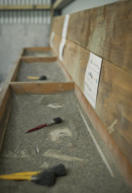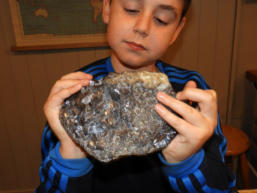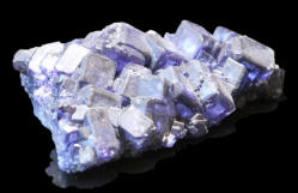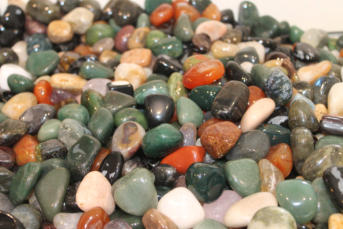

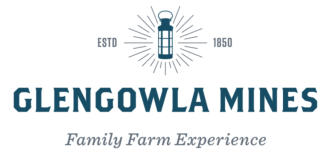
Geology Tours Ireland
Geology Tours Connemara Ireland.
The Island of Ireland including Connemara has a geology history which goes back hundreds of millions of years. Here at Glengowla Mines, we show case the geological finds buried beneath the Connemara Mountains. Our underground mine tour, has been the highlight of many geological enthusiasts Irish tours over the years. The mine is noted for its rare and beautiful octahedral crystals of fluorite and quartz. In the Natural History Museum in London there is a piece of fluorite, pale green octahedron 7cm. across with calcite, galena and pyrite from Glengowla on display. Our knowledgeable tour guides give a very engaging tour. Guest speakers can also be organised by request. If you are a Tour Operator, Coach Operator or Group Organiser contact us today for rates and packages.
Glengowla Mines, Glengowla Oughterard, Co Galway H91 PX22


Galway has some of the most complex geology in the whole of Ireland. Ancient metamorphic rocks such as schist and gneiss (pronounced as ‘nice’) occurthrough
Connemara from Galway City to Inishbofin.
The whole of Connemara is a very big structure with massive folds. It is part of the Dalradian sequence that also occurs in North Mayo, Donegal and through into
western Scotland. There are even older Precambrian rocks in a very few places exposed by massive faults.
Many large areas, such as Connemara, are defined as terranes. These are sequences of rocks that were formed in one place and are now alongside other sequences that
were originally formed a long way apart. Major faults in the Earth’s crust (perhaps like the San Andreas Fault in California) have brought them together over millions of
years.
The Twelve Bens of Connemara are made of metamorphosed sandstone,which is quartzite. They form hills because they are more resistant to erosion over long periods
than the other rocks. Running along the base of the hills are areas of metamorphosed limestone, which is marble, marble is white if the limestone was pure, but the
addition of a few impurities means that the Connemara marble has green bands through it.
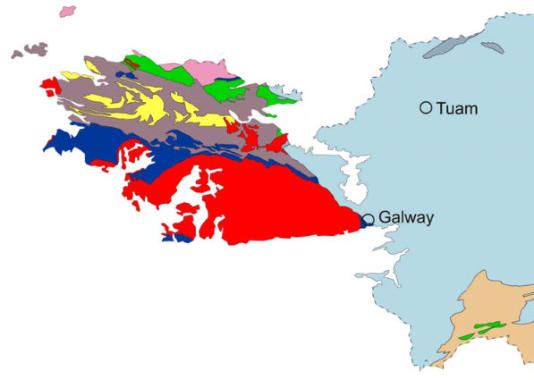
Map Legend
Pale purple: Precambrian Dalradian rocks; Pale Yellow: Precambrian quartzites; Pink:Ordovician; Dark blue: Ordovician igneous & volcanic rocks; Green:Silurian; Red:Granite; Beige: Devonian sandstones and conglomerates; Blue grey:LowerCarboniferous sandstones; Light blue:Lower Carboniferous limestone




General
Things to Do
Groups tours









Telephone +353(0)87 252 9850 or

Geology Tours Connemara
The Island of Ireland including Connemara has a geology history which goes back hundreds of millions of years. Here at Glengowla Mines, we show case the geological finds buried beneath the Connemara Mountains. Our underground mine tour, has been the highlight of many geological enthusiasts Irish tours over the years. The mine is noted for its rare and beautiful octahedral crystals of fluorite and quartz. In the Natural History Museum in London there is a piece of fluorite, pale green octahedron 7cm. across with calcite, galena and pyrite from Glengowla on display. Our knowledgeable tour guides give a very engaging tour. Guest speakers can also be organised by request. If you are a Tour Operator, Coach Operator or Group Organiser contact us today for rates and packages. Telephone +353(0)87 252 9850 or
Map Legend
Pale purple: Precambrian Dalradian rocks; Pale Yellow: Precambrian quartzite’s; Pink: Ordovician; Dark blue: Ordovician igneous & volcanic rocks; Green:Silurian; Red:Granite; Beige: Devonian sandstones and conglomerates; Blue grey:Lower Carboniferous sandstones; Light blue:Lower Carboniferous limestone
Galway has some of the most complex geology in the whole
of Ireland. Ancient metamorphic rocks such as schist and
gneiss (pronounced as ‘nice’) occur through Connemara
from Galway City to Inishbofin.
The whole of Connemara is a very big structure with
massive folds. It is part of the Dalradian sequence that also
occurs in North Mayo, Donegal and through into western
Scotland. There are even older Precambrian rocks in a very
few places exposed by massive faults.
Many large areas, such as Connemara, are defined as
terranes. These are sequences of rocks that were formed in
one place and are now alongside other sequences that were
originally formed a long way apart. Major faults in the
Earth’s crust (perhaps like the San Andreas Fault in
California) have brought them together over millions of
years.
The Twelve Bens of Connemara are made of
metamorphosed sandstone,which is quartzite. They form
hills because they are more resistant to erosion over long
periods than the other rocks. Running along the base of the
hills are areas of metamorphosed limestone, which is
marble, marble is white if the limestone was pure, but the
addition of a few impurities means that the Connemara
marble has green bands through it.










Glengowla Mines, Glengowla Oughterard, Co Galway H91 PX22



